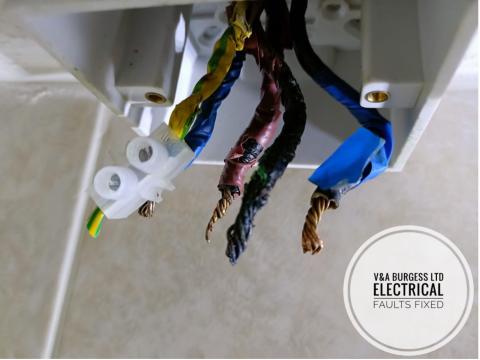
This is a question that we are asked a lot. Most of the time it is just after our arrival at a property where the power has gone out, the consumer unit has tripped or something has melted, burnt, lights flickered and so on. It is understandable that you want to know immediately from a professional that your home is safe and we want to give you that reassurance. There are some signs that may mean your wiring is really old or even unsafe, such as:
- Plug Sockets fitted in Skirting Boards
- Old Fuse Box without Trip Switches
- Lights in Bedrooms are near windows
- Very few Plug Sockets
- Flickering Lights
- Burning Smells
- Crème coloured switches and sockets
The Picture shown is a wire that is beginning to overheat, has not been terminated correctly or at the sufficient torque / tightness level as recommended by the manufacturer. We caught this just in time and prevented a fire from happening. No homeowner would have known about this.
Back to top1) Plug Sockets fitted in Skirting Boards
Plug sockets have not been installed in skirting boards since around the 1960s. The practice was common in earlier years also. Whilst electrical sockets in skirting boards may not be practicable nor compliant with the modern wiring regulations it does not necessarily mean that the situation is dangerous. It can indicate that the wiring installation may be very old however.
Where there are socket outlets installed in the skirting boards, an electrician should check these and the general wiring installation to determine age as the installation may have been rewired at some point and the original socket locations kept but with new cabling run to each point.
Back to top2) Old Fuse Box without Trip Switches
Trip switches in consumer units became commonplace from the early 1980s as older style rewireable fuse boxes were phased out. These will still be in place in some older houses. Some newer consumer units had a mixture of actual trip switches and more modern fuse carriers containing cartridge fuses similar to those found in plug tops.
If you have an old-style fuse box then your wiring is AT LEAST as old as the fuse box if not older. Just because your wiring is old does NOT MEAN that it is unsafe however. Old style fuse boxes do not generally have circuit breakers or devices for protection against electric shock.
I would strongly recommend that if you have one of these fuse boxes, that you have your wiring and fuse box checked by an electrician by means of an electrical inspection. This will determine if there are any dangerous issues, the rough age of the wiring system and when a rewire may be necessary.
Back to top3) Lights in Bedrooms are near Windows
Another practice that has not been seen for many decades was the installation of the lighting point for the bedroom near the window. This was not an unsafe practice but it can indicate that your wiring may be very old. I have not seen this since the 1960s so can assume that the practice stopped around then in general.
Since then, lighting points in bedrooms have generally been installed more centrally to the bedroom ceiling to cast better light throughout the room.
The property could have been rewired and utilised the same point for the lighting cable of course so its worth checking or asking an electrician to check how old the wiring is.
Back to top4) Very few Plug Sockets
In many homes up until about the 1980s, there were very few plug sockets installed into homes. It was fairly typical to have just one single socket installed in each bedroom as there was not much need for additional plug socket outlets.
These days we have a whole variety of equipment that needs powering. Many of us will have two bedside lamps, two mobile phones that need charging, an electric blanket and other electrical devices that require more than one single socket outlet in each room to be installed.
Back to top5) Flickering Lights
Flickering lights could be an indication that not everything is right. There could be issues with the light bulbs, the light switches or lighting circuit itself. There could also be more serious electrical problems elsewhere in the wiring installation. A degree of concern and associated investigation is necessary if you have flickering lights and our article goes into great detail about the issues that could cause flickering lights.
Back to top6) Burning Smells
An Electrical burning smell is one of the warning signs that there may be faulty wiring or the home’s wiring is under stress and may not be safe. If you can smell any strange fishy, plastic or burning smells in your home and suspect that it is coming from the wiring then it is important to turn your electric off as quickly as possible. There is normally a main switch in or near your consumer unit or fuse box to do this.
When electrical burning takes place, great damage can be done to the wiring system especially where there is burning in the fuse box as this contains ALL the circuit cables for the wiring system in the home and several expensive components.
If electrical burning takes place in the fuse box or consumer unit then quite often the whole unit needs to be replaced.
Other common sources of electrical burning smells are the:
- Electric Shower – Usually the pull cord or wall switch will give up first closely followed by the trip switch in the consumer unit.
- Electric Cooker - Normally the wall switch will be affected before anything else but sometimes it can be the connections in the fuse box or consumer unit that will be affected first.
- Car Charging Equipment – Another high-power electrical circuit that is affected by loose connections, electrical faults, and overheating.
7) Crème coloured switches and sockets
Up until around the 1970s the colour of most basic electrical accessories in the home wiring system was crème. There were the usually brass or other stylish switches and sockets installed but the basic colour was crème. The standard basic electrical accessories in 2024 is a clean white colour and has been for many decades.
Whilst these switches and sockets from the 70s and beforehand may be ok there could be worn parts, loose wiring or overheating of connections going on behind the scenes. These factors present a danger and should not be left to continue.
One way of preventing such danger is to have an electrical inspection carried out to check if there is old electrical wiring, loose connections leading to high resistances on the sockets, lights, or other electrical circuits.
If your electrical accessories are several decades old then it may be sensible to have them swapped over for new ones.
Back to top8) Typical Dangers of Unsafe Wiring
Your home’s electrical wiring needs to remain in good condition to minimise potential problems. An old house may have hidden electrical dangers and old wiring that may not be seen. This can lead to:
- Short Circuit
- Electrical Fires
- Electric Shocks
Short Circuit:- House wiring does not last forever and things can degrade and go wrong. A typical issue with house wiring is when the wiring insulation breaks down and gives rise to electric shock risk as electric current is allowed to move through the cable insulation to earthed metal parts of the wiring installation. Failed cable insulation can lead to metal parts becoming live. If your home has cloth wiring, aluminium wiring, lead sheathed wiring or rubber cables then these likely need to be replaced.
Electrical Fires:- Old homes with old electrical wiring are more at risk of house fires due to bad wiring, a loose connection in the breaker panel or junction boxes and elsewhere in the electrical wires. New wiring added on to older electrical systems can also give rise to fire risk so its important to have any electrical work carried out by only a professional electrician.
Electric Shocks:- Without special devices such as RCD (residual current devices), GFCI (Ground - Fault Current interrupters) or others. There is little electric shock protection other than the earth wiring in the property. The Earthing Wire or Ground Wire is vitally important to the electrical system and in some older properties there may not be one!
Back to top9) Common Questions and Answers:
9.1) How do I check my home electrical wiring?
There are several checks that you can do yourself to ensure that the electrical environment in your home is safe. Beyond those checks, an electrician will be needed to safely carry out more in-depth checks on the wiring and its condition.
Our article covers what may be safe to check yourself and what should perhaps be checked by an electrician.
An electrician can, of course, check all the cabling including the electrical appliance cabling from plug top to appliance. A full Electrical Safety Check is of course the best way of establishing the condition of the wiring.
“Why do we need to do this?” I hear you cry…. Well, it’s a matter of safety. Over time connections can become loose, components can wear out, electrical accessories can become damaged, building works / alterations / DIY can cause damage and so on.
9.2) How much does an Electrical Safety Check cost UK?
The cost of an Electrical Safety Check for a home’s electrical system can vary and as such, you should discuss with your electrician, what is included in that cost. Cheaper electrical checks will often not include the electrical report, will contain excessive limitations (things that haven’t been checked) and will often be carried out in a rush leaving no time for any real inspection.
Most homes will cost between £200-£400 depending upon the size of property, size of fuse box / consumer unit and obstacles preventing the inspector from accessing all electrical points and light fixtures in the home. The inspection should take several hours to carry out including producing the paperwork which, in itself, takes around 40 minutes or so.
Suspicion should be aroused where electrical inspections are carried out very quickly and doubt raised as to their relevance, accuracy, and value.
9.3) Can you tell the safety of an installation by visually checking?
There is no way to tell how safe an installation is just by looking at it. We can ascertain how dangerous it is likely to be, how out of date wiring is, how old your consumer unit is, how many regulations your wiring fails to comply with and so on. Telling you your installation is safe just by looking at it is not something we can quickly and easily do.
This is why Electricians test and inspect your wiring installation for you. This is a recommendation from the Institute of Engineering and Technology. The recommended testing interval is every 10 years. Now I can safely say I know virtually no member of the public that is aware of this let alone has this testing carried out in their homes at the recommended frequency.
A professional, qualified electrician can inspect and test your electrical system in your home. They can cast their experienced eye over the electrical accessories, the resistances in your wiring, the quality of the insulation of your cabling, the condition of the installation as a whole and then give you an in-depth detailed report on its condition. This will detail and necessary changes, any dangerous problems that need to be dealt with immediately and any recommendations regarding the safety of your electrical installation.
9.4) How old is TOO old for Electrical Wiring?
Brace yourself,
If your older home has an electrical installation that is 60 years old then it is likely you will be heading for a rewire. Not definite but, once installations reach this sort of age then they are heading for the end of their usable life. We regularly see installations that are in excess of this age that are just fine however they do require some work in order to bring them up to date and into compliance with current safety regulations.
Some installations can go on much longer providing service and some are absolutely finished within a couple of decades. It all depends on the use and the test results we are able to obtain on the condition of your wiring.
The important thing is not to worry. Not to stress and never to panic. No matter what state you believe your wiring is in, you can call us to come and look, test, and offer advice. We are here for you and will always give you an honest appraisal of your electrical installation.
Back to top










